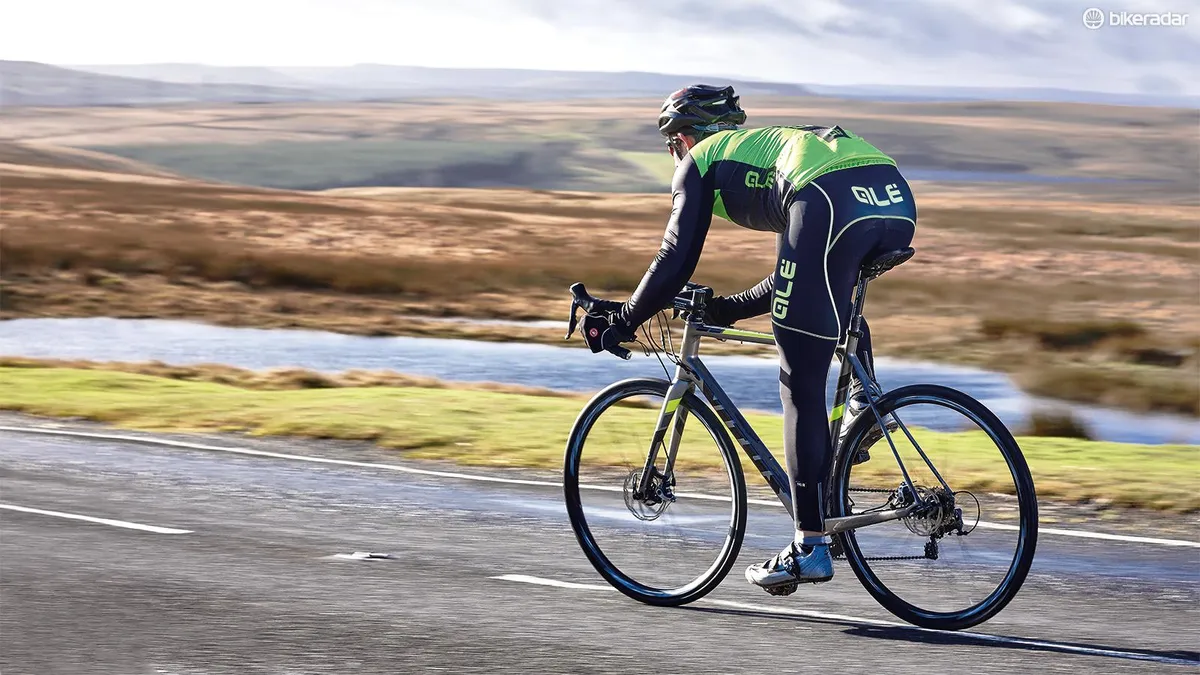Vitus has long been associated with racing. In its original French incarnation back in the 1980s, Sean Kelly powered lugged skinny aluminium Vitus bikes to victories in races such as Milan-San Remo.
In its new post-2011 guise – now as part of Northern Ireland’s Chain Reaction Cycles – Vitus sponsors the An Post Sean Kelly cycling team. Not surprisingly we expected a pretty racy number and the first glance of the Venon VR’s clean, slender lines seemed to bear that out. It was only when we started riding that we got a sense of what the VR is truly about.
A pleasant place to sit
‘Smooth’ is the first word that springs to mind, with ‘floaty’ joining it in the Venon’s big book of cycling adjectives. It rapidly became a very pleasant place to spend a few hours, and we revelled in its ability to keep going at a brisk rate over the rolling terrain of England's South West.

The Venon really comes into its own on ascents where the quality Fulcrum wheel and Continental tyre pairing eases you up climbs in comfort. It’s not quite so impressive on the descents, where the smoothness that’s so welcome everywhere else means you feel slightly disconnected when you’re really pushing hard into an apex, and we never felt as confident with the Venon when we were really riding on the limit. But for long days out, and events like gran fondos or sportives, the Venon would make an excellent companion.
The own-brand saddle was reasonable, if not exceptional, but comfort was certainly helped by the slimline 27.2mm carbon seatpost, which is always a welcome addition on an endurance-biased bike. The same can’t be said of the aluminium bar – its slender dimensions and stiffness mean you can really feel it through your hands and wrists whenever you hit a rut or pothole.
Replacing the rather skinny bar tape or putting padding underneath would help, at least to some extent. But it’s still a slight letdown on a bike with such a smooth ride.
Disc brakes by design
The rear has a 12mm thru-axle, the front a 15mm thru-axle, which are designed to work with disc brakes. The Venon’s TRP Spyre cable discs are very good, aided by the 160mm front rotor, though you never quite get the same feel of progressive power throughout the brake lever’s travel as you do from a hydraulic setup.

This might seem that we’re being overly critical when it comes to the Vitus, as the Venon VR is a bike with plenty of charm. The lightness of its ride and its smooth-rolling comfort – apart from the bar – make it an extremely capable endurance machine, and one we’d happily employ for day-long events.
That said, it doesn’t quite reach the high watermark levels achieved by bikes such as BMC’s GF01 or Cannondale’s Synapse. But if your riding is more mile-eating than big thrills, the Venon might well be the a discerning choice.
Vitus Venon VR Disc specifications
- Sizes (*tested): 50, 52, 54, 56, 58*, 60cm
- Weight: 8.6kg
- Frame: T700 UD Carbon
- Fork: Carbon
- Chainset: Shimano Ultegra 172.5mm, 50/34t
- Bottom bracket: Pressfit
- Cassette: Shimano CS-HG5800 11-28t
- Chain: KMC
- Derailleurs: Shimano Ultegra
- Shifters: Shimano Ultegra
- Wheelset: Fulcrum Racing 5DB disc
- Tyres: Continental Grand Sport Race 700x25c
- Wheel weight: 1,480g (f), 1,850g (r)
- Stem: Vitus alloy 31.8mm, 120mm
- Bar: Vitus alloy 31.8mm 43cm
- Headset: Token Omega3
- Saddle: Vitus
- Seatpost: Vitus carbon 27.2mm
- Brakes: TRP Spyre mechanical discs
Vitus Venon VR Disc geometry
- Seat angle: 73 degrees
- Head angle: 74 degrees
- Chainstay: 41.5cm
- Seat tube: 52cm
- Top tube: 57.5cm
- Fork offset: 4cm
- Trail: 8.6cm
- Wheelbase: 1,000mm
- Price: £1,800 / US$2,150 / AU$3,806




